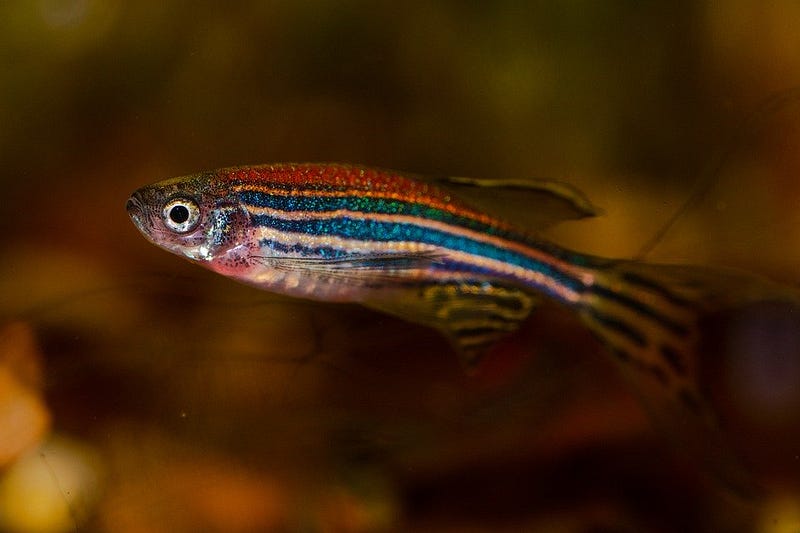Diving Into The Research Pool Of Aquatic Animal Models: Dr. James Monaghan’s Lab
By Spurti Vemuri, Behavioral Neuroscience, 2021

This article was originally published as part of Issue 33: Water.
Although when one thinks of scientific research with animal models one usually thinks of mice or rats, a large branch of animal research involves aquatic animals. More specifically, aquatic vertebrates are good representatives for human disease because, just like you and me, they have a spinal cord and vertebrae. In addition to the physical similarities, most of the genetic makeup of aquatic animals is like that of humans. This allows researchers to manipulate an aquatic vertebrates’ genes and observe how these mutations physically manifest themselves. Another benefit is that aquatic vertebrates not only have physical similarities to humans, but they allow researchers to visualize these similarities through development. Instead of growing in the womb like a terrestrial vertebrate would, aquatic vertebrates lay eggs and therefore develop externally. So, although mice have been dominating the labs as the most common models of human disease, aquatic vertebrates provide much more insight into the physical properties of diseases and mutations that mice cannot. For example, if a researcher is studying a developmental defect, it is helpful to be able to see what is happening at every stage. Some of the most common aquatic animals used as models for human disease are Zebra fish (Danio rerio), African clawed frog (Xenopus laevis), and the Mexican axolotl salamander (Ambystoma mexicanum).
Although mice have been dominating the labs as the most common models of human disease, aquatic vertebrates provide much more insight into the physical properties of diseases and mutations that mice cannot.
Dr. James Monaghan is a faculty member of Northeastern University and studies Regeneration Biology. With the help of post-docs, graduate students, and undergraduate volunteers, the Monaghan Lab utilizes the amazing regenerative capability of Ambystoma mexicanum, also known as the axolotl, to investigate the properties of tissue regeneration in humans. In order to conduct these investigations, the axolotls are bred within the lab and monitored throughout development. The research assistants that work at the lab are responsible for axolotl care, cleaning the tanks, monitoring water quality, and running experiments. The laboratory that hosts these salamanders is equipped with state of the art water filtration systems that regulate temperature, pH, and salt.
The axolotl is a unique species of salamander that can lay anywhere from 300 to 900 eggs which mature in the span of a year. This cost-efficient reproductive capability and their genetic similarity to humans make them good subjects. Axolotls are also reliable specimen to breed in captivity and do not need to be collected from a pond, unlike other salamander species. Furthermore, a genetic mutation that causes axolotls to remain at the tadpole stage of metamorphosis throughout adulthood sets them apart from other salamanders. Being able to understand the “metamorphic control” axolotls possess may help unravel the mystery of aging and the processes that regulate maturation in humans. An axolotl possesses the amazing ability to regenerate its limbs, tail, parts of the brain, and even the spinal cord. The fact that it can do so while remaining in a juvenile stage of development makes them unique. Imagine if senior citizens had the ability to grow back an arm while still looking like teenagers!
Imagine if senior citizens had the ability to grow back an arm while still looking like teenagers!
The Monaghan Lab researches the underlying cellular and molecular properties of regeneration in the salamanders and how they relate to humans by conducting experiments that explore gene expression patterns of the Mexican axolotl. Once the gene candidates are identified, the lab is able to conduct more specific experiments such as skin regeneration for scar-free healing in vertebrates, nerve dependent limb generation, and ovary regeneration. The ability to raise and study axolotls in an environmentally controlled system allows for the exploration of a broad range of biological concepts like regeneration, human infertility, aging, and gene expression.
When Dr. Monaghan first joined the field in 2003, there were only about one hundred genes available in the entire human genome. After the DNA sequencing explosion, many researchers studying genomics had access to the entire genome and had a stronger foundation to perform research. Earlier, they were only able to pinpoint where a gene is turned on and off. But according to Dr. Monaghan, gene knockouts are the next frontier for genetics research. Just as the boom in DNA sequencing allowed many opportunities to perform research in the field of regenerative biology, the new ability to edit the genome will have the same effect on new research techniques over the next decade. As our knowledge of genomics and biology continues to advance, the pool of research utilizing aquatic animals as models will only continue to expand.
